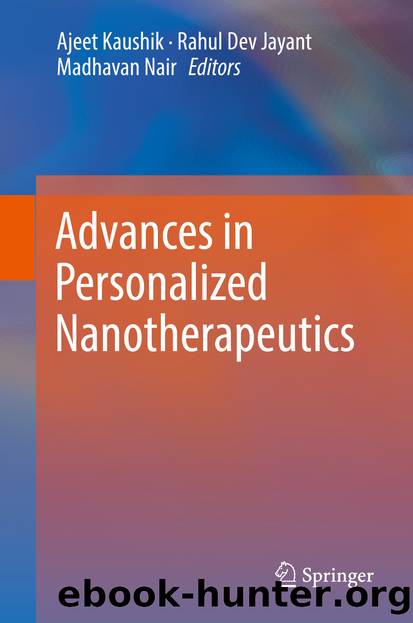Advances in Personalized Nanotherapeutics by Ajeet Kaushik Rahul Dev Jayant & Madhavan Nair

Author:Ajeet Kaushik, Rahul Dev Jayant & Madhavan Nair
Language: eng
Format: epub
Publisher: Springer International Publishing, Cham
3 Magnetic Fields Responsive Hydrogels
Magnetic hydrogels have significantly gained attention in last few years owing to their on demand drug release characteristics and enhanced controllability [17]. The synergism of the magnetic nanoparticles (e.g., −Fe2O3, Fe3O4, CoFe2O4) and the polymeric matrix result in superparamagnetic hydrogels and hold potential for drug delivery and tissue engineering . The magnetic hydrogels have been known to synthesize by various methods including blending, an in situ precipitation method or grafting-onto method. The type and the properties of the magnetic hydrogel depends on the type of hydrogel matrix, magnetic character of nanoparticles as well as their size and concentration [18]. From the last few years the magnetic hydrogels have been intensively applied for tissue engineering applications. The magnetic hydrogels as building blocks may be assembled to form complex tissue constructs with biological agents when implanted in the body. These hydrogels have attracted the in vivo cells and growth factors. The most eminent characteristic features of the magnetic scaffolds is their ability to stabilize and occupy the growth factors and bind the biological agents through the external magnetic field which simultaneously provide nutrition initial cell seeding and cell proliferation. These scaffolds give frequent response to the physical cues like mechanical stimulus by interacting between the magnetic nanoparticles and the alternating magnetic field (AMF) further control the cell biological behavior in the angiogenesis process in vitro. The other factors which can be controlled by alternating the frequency of the applied field is the stress parameter. Thus magnetic hydrogels are eligible candidate for pulsatile drug delivery and soft actuators. Further recent works shows that the mechanical stimulation induced by the magnetic forces have shown to bind the magnetic particles to the membranes of mesenchymal stem cells (MSCs) for simulation of calcium stores, upregulation of genes for bone and cartilage regeneration and mineralization. One of the interesting study by Polyak et al. [19] demonstrated the use of magnetic alginate composite scaffolds for physical simulation to cells. Elevated metabolic activity during the simulation period was observed when magnetite–impregnated alginate scaffolds are seeded with aortic endothelial cells stimulated during the first 7 days of 14 day experimental. It was also observed that the expression of proliferating cell nuclear antigen PCNA indicated the magnetically stimulated cells exhibit the lower proliferation index as compared to the non-stimulated cells. Figure 8.3 shows the SEM images which demonstrate the pore size and porous morphology of scaffolds that are not affected by the magnetic nanoparticles concentration. The study shows that the particles are homogeneously embedded in the hydrogel matrix and also indicate that the alginate- stabilized nanoparticles have fine interaction with the matrix to form the homogeneous composite materials. Recently, the concept of self-healing hydrogels have gained significant attention. They have the capability to self-repair after the damage as the biological systems does. They are known as functional materials that exist in the injectable forms and have the capacity to regenerate the integral network and sustain at the target position. One of the interesting studies showed that chitosan-Fe3O4
Download
This site does not store any files on its server. We only index and link to content provided by other sites. Please contact the content providers to delete copyright contents if any and email us, we'll remove relevant links or contents immediately.
| Automotive | Engineering |
| Transportation |
Whiskies Galore by Ian Buxton(41885)
Introduction to Aircraft Design (Cambridge Aerospace Series) by John P. Fielding(33064)
Small Unmanned Fixed-wing Aircraft Design by Andrew J. Keane Andras Sobester James P. Scanlan & András Sóbester & James P. Scanlan(32744)
Craft Beer for the Homebrewer by Michael Agnew(18145)
Turbulence by E. J. Noyes(7942)
The Complete Stick Figure Physics Tutorials by Allen Sarah(7310)
Kaplan MCAT General Chemistry Review by Kaplan(6868)
The Thirst by Nesbo Jo(6832)
Bad Blood by John Carreyrou(6558)
Modelling of Convective Heat and Mass Transfer in Rotating Flows by Igor V. Shevchuk(6392)
Learning SQL by Alan Beaulieu(6213)
Weapons of Math Destruction by Cathy O'Neil(6151)
Man-made Catastrophes and Risk Information Concealment by Dmitry Chernov & Didier Sornette(5925)
Digital Minimalism by Cal Newport;(5667)
Life 3.0: Being Human in the Age of Artificial Intelligence by Tegmark Max(5478)
iGen by Jean M. Twenge(5367)
Secrets of Antigravity Propulsion: Tesla, UFOs, and Classified Aerospace Technology by Ph.D. Paul A. Laviolette(5311)
Design of Trajectory Optimization Approach for Space Maneuver Vehicle Skip Entry Problems by Runqi Chai & Al Savvaris & Antonios Tsourdos & Senchun Chai(5012)
Pale Blue Dot by Carl Sagan(4915)
